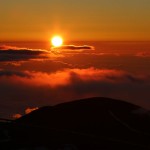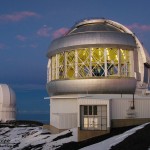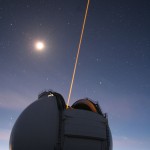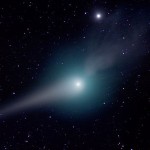A snowfall on the summit of Mauna Kea in mid-summer. A very pretty event, always nice to have some white atop the white mountain. It is even a better as a contrast to the very hot weather we have been having down below. Everyone has been commenting on the unusually warm weather, particularly Hilo residents who have suffered through record breaking warm days and near 100% humidity.

I have been raised on Big Island all my life (which is a long time) and I have NEVER heard of it snowing in July, snow in May is the talk of the town, but in July? It is a miracle! Especially with the hot humid temperature breaking records, how did a trough get through? It must be a message from above and Poliahu’s blessings to our Mauna Protectors. Now all we need is the Kamakani to blow all of the existing telescopes away! EO – Anela2 comment on the West Hawaii Today website
I would point out to the comment author that I have photos in my archive of midsummer snows from almost all of the last eight summers. I can not remember a summer that has not featured snow atop the mountain, even if my photo collection is not complete. Snow can happen anytime of the year on the summit of Mauna Kea. Most summer snows are like this one, fairly minor and mostly melted away by the end of the day.
If the TMT goes up, I can be that this type of thing won’t happen anymore. That monstrosity will block the trough’s moving through the island as well as the winds. It will throw everything off. – Shalee Kekawa comment on the West Hawaii Today website
Either this is a good example of Poe’s Law, or the author really believes that, a truly sad state of science literacy. It gets worse…
Is anyone testing the snow for any chemicals sprayed from the sky? – Josephine Keliipio Facebook comment
An astute observer will note this same sort of occurrence whenever something unusual happens. A few volcanic eruptions hit the news within a few days and people are claiming it is a sign of imminent apocalypse. While anyone who pays attention to volcanoes is fully aware that 12-20 volcanoes are erupting at any given time on the planet, the event is nothing unusual. Earthquakes are good for the same phenomena.
This common misconception occurs when a person’s attention is attracted to something they do not normally pay any attention. Without any baseline data stemming from experience, everything seems new and unusual. I have yet to see a name for this phenomena, though I am sure it exists.
With all of the attention paid to Mauna Kea this year, I really expect this sort of thing to happen again… And again… And…










